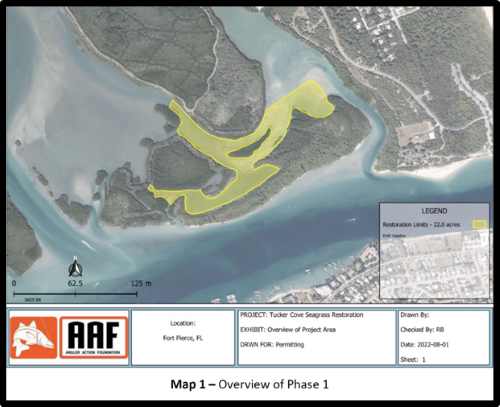“If success were easy, everybody would do it.”
-John Hawkings

Closer to our current truth: If it was easy, we wouldn’t NEED to be doing it.
Growing seagrass is hard, but not impossible. Inspired by our success in the Caloosahatchee River (planting mostly freshwater Vallisneria [tape grass]) with our primary contractor Sea & Shoreline, the Angler Action Foundation (AAF) next moved to tackle the recent decline of seagrasses in the Indian River Lagoon.
After pilot studies and several planning meetings, the area of Tucker Cove seemed like the perfect place to reestablish beds of shoal and manatee grasses. Tucker Cove is very close to the St. Lucie Inlet, located just inside on the north side, so there will always be a good amount of clean ocean water flushing across the once lush flat. Still, it isn’t as easy as planting it and swimming away…
An initial planting of shoal grass several months ago didn’t have the success we expected. While there is still grass that we planted, it isn’t taking off as well as we projected. There have been a handful of challenges, including poorer water quality on incoming tides than we observed during pilot studies, and intense biofouling on our cages which were deployed to protect the grass from grazing by manatees, crabs, birds, fish and other critters.
The cause of the poor water quality remains a mystery. For a few months now, the water by the inlet has often been more clear on the outgoing tide than the incoming. Further, at high outgoing tide we have observed evidence of freshwater plants in the area. The latter might be due to changes in pump schedules of nearby mosquito control canals, the former is anyone’s guess. Nearby dredging projects maybe? Regardless, these issues make things tough but not impossible.

The heavy biofouling was a different story. The cages, or Hervibory Exclusion Devices, patented by our partner Sea & Shoreline, had a 1-inch mesh. Even with crews deploying monthly to scrub the cages clean, there was problems with sunlight blockage. Seagrass, just like all plants, need sunlight to survive.
Never willing to accept failure, Sea & Shoreline went ahead and removed all of the cages, and built new ones with larger mesh openings. These new cages were deployed in July, and will continue to be scrubbed monthly. An additional 700 plants were brought in from the farm, half shoal grass and half manatee grass. Biologists will continue to monitor things like water temperature, sunlight penetration and salinity, and we will adjust as needed to ensure complete success of the project.
To date, about 20 acres have been planted in the area. An additional 40 acres has been funded and will be planted once permitting has been completed. This expansion has proven to be key to the overall success, as scaling up significantly increases the overall success rates in similar projects around the state (projects in the Caloosahatchee and Crystal River, the latter by the group Save Crystal River, are references).
Tucker Cove and the adjacent flats are areas I have kayaked and fished for the past 25 years. This has given me a personal understanding of just how valuable healthy seagrasses are in these local waters. It also has given me the same unwillingness to accept failure as Sea & Shoreline – we intend to do whatever is necessary to bring grass back to these once productive flats which were prowled by gamefish, used as nurseries for numerous critters, and fed a wide variety of animals including manatees.
We’re all looking forward to days of improved habitats and water quality, and enjoying the fishing that will most assuredly come with those improvements. Stay tuned!
To receive regular updates on our seagrass projects, fishing tournaments, product reviews and how-to fishing articles – all original content – be sure to subscribe to our newsletter!
Seagrass rules!

